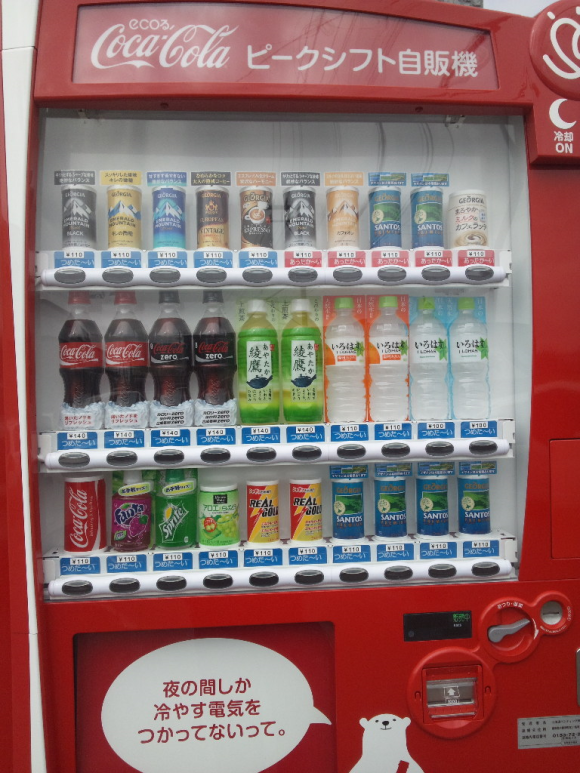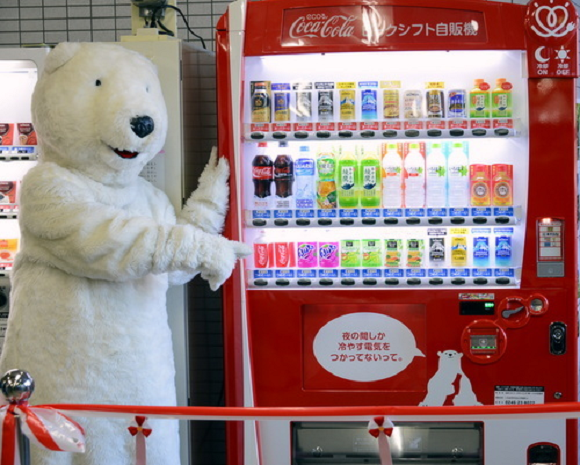
In some ways, the huge amount of vending machines in Japan seems like a win-win situation. In a country that gets incredibly hot and sticky in the summer, it’s nice to never be more than a few minutes’ walk from a cold drink, and for beverage companies like Coca-Cola, the machines are a huge source of income.
That said, all of those vending machines are essentially coin-operated refrigerators, collectively sucking up a huge amount of electricity. In an effort to cut down on their energy consumption, Coca-Cola has developed a new type of unit that spends as much as 16 hours a day not using any electricity at all to keep its products nice and cool.
Coca-Cola began its development push for the new, more environmentally friendly machines in the wake of the 2011 earthquake and tsunami that struck Japan’s Tohoku region. During the resulting power shortage, then-governor of Tokyo Shintaro Ishihara pointed to pachinko parlors and vending machines as two relatively indignantly large drains on the power grid, and many of the latter were shut down or had their cooling functions dialed back as Japan recovered from the natural disasters.
This development led to greater public concern over the ecological effects of the country’s vending machines, which in turn led soft drink companies in Japan to look for ways to revise their business practices. At Coca-Cola Japan, this led to what its engineers dubbed the Apollo Project, which resulted in the development of what the company is calling peak shift vending machines.
▼ Peak shift (ピークシフト) can be seen written at the top of the new machines.
Leading the development team was Planning Group Manager Yasuo Nakazato, who was given the difficult task of reducing electricity usage without increasing the machine’s dimensions or sacrificing beverage storage space.
To accomplish this goal, the team swapped out the previously used urethane foam for vacuum insulated panels. The new material is 10 times thinner than the old one, but boasts superior insulating capabilities. It’s so effective that there’s no need to actively cool the machine’s beverages between 7 a.m. and 11 p.m. Instead, the drinks are cooled overnight, and maintain their low temperatures during the day.
Coca-Cola began testing the new machines in August of 2012 in cities of Japan known for their scorching hot weather, such as Saitama Prefecture’s Kumagaya and Gifu’s Tajimi. Following these successful test runs, the company has been installing them throughout Japan. In speaking with reporters this summer, Coca-Cola Japan President Tim Breatt said that the project, in which some 20 billion yen (US$198 million) has been invested over the past two years, has so far resulted in the installation of 60,000 peak shift vending machines.
This doesn’t mean Coca-Cola’s job is over, though. Breatt also revealed that the company’s target is for the new eco-friendly units to account for over half of its vending machines in Japan by 2020. Here’s hoping they reach that goal, keeping us refreshed and the earth happy at the same time.
Source: Sankei News
Top image: Hi Ciao
Insert images: Hi Ciao, Yahoo! Japan, Ameblo



 World’s first hydrogen powered vending machine unveiled by Coca-Cola at Osaka-Kansai Expo
World’s first hydrogen powered vending machine unveiled by Coca-Cola at Osaka-Kansai Expo Coca-Cola’s newest Japan flavor is Bleach (with a capital B)
Coca-Cola’s newest Japan flavor is Bleach (with a capital B) Coca-Cola raises prices in Japan for the first time in 27 years
Coca-Cola raises prices in Japan for the first time in 27 years Coca-Cola’s hot canned shrimp bisque: The newest reason Japanese vending machines are awesome
Coca-Cola’s hot canned shrimp bisque: The newest reason Japanese vending machines are awesome Coca-Cola to release their healthiest cola ever in Japan this March
Coca-Cola to release their healthiest cola ever in Japan this March Disillusionment at Tsukiji’s tourist-target prices led us to a great ramen restaurant in Tokyo
Disillusionment at Tsukiji’s tourist-target prices led us to a great ramen restaurant in Tokyo How to get your money’s worth at an all-you-can-eat crepe challenge in Japan
How to get your money’s worth at an all-you-can-eat crepe challenge in Japan Starbucks Japan releases the new Soupuccino, but is it everything it’s cracked up to be?
Starbucks Japan releases the new Soupuccino, but is it everything it’s cracked up to be? Hafu: Telling the story of Japan’s mixed-race minority and changing attitudes in society【Q&A】
Hafu: Telling the story of Japan’s mixed-race minority and changing attitudes in society【Q&A】 Japanese woman mistaken for bear
Japanese woman mistaken for bear A Japanese dating app matched our bachelorette with a Buddhist monk, and she learned some things
A Japanese dating app matched our bachelorette with a Buddhist monk, and she learned some things Tokyo adding new anti-littering fines in Shibuya and Harajuku, will require more trash cans too
Tokyo adding new anti-littering fines in Shibuya and Harajuku, will require more trash cans too Drunk cycling can result in an instantly suspended driver’s license in Japan
Drunk cycling can result in an instantly suspended driver’s license in Japan This Japanese pub with one-yen bottles of sake broke our brain and made our day
This Japanese pub with one-yen bottles of sake broke our brain and made our day 200 Years Old And Still Irresistibly Adorable! A Timeless Image of “Cute” From the Edo Period
200 Years Old And Still Irresistibly Adorable! A Timeless Image of “Cute” From the Edo Period 7-Eleven Japan starts new temporary luggage storage service in over 300 branches
7-Eleven Japan starts new temporary luggage storage service in over 300 branches Starbucks teams up with 166-year-old Kyoto doll maker for Year of the Horse decorations【Photos】
Starbucks teams up with 166-year-old Kyoto doll maker for Year of the Horse decorations【Photos】 Tokyo’s Tsukiji sushi neighborhood asks tour groups to stay away for the rest of the month
Tokyo’s Tsukiji sushi neighborhood asks tour groups to stay away for the rest of the month Starbucks Japan releases new zodiac chilled cup drink for 2026
Starbucks Japan releases new zodiac chilled cup drink for 2026 Street Fighter Hadouken Churros to be launched and eaten in Tokyo, Okami pudding on offer too
Street Fighter Hadouken Churros to be launched and eaten in Tokyo, Okami pudding on offer too Is this the most relaxing Starbucks in Japan?
Is this the most relaxing Starbucks in Japan? Starbucks on a Shinkansen bullet train platform: 6 tips for using the automated store in Japan
Starbucks on a Shinkansen bullet train platform: 6 tips for using the automated store in Japan Large amount of supposed human organs left in Osaka marketplace
Large amount of supposed human organs left in Osaka marketplace Japan may add Japanese language proficiency, lifestyle classes to permanent foreign resident requirements
Japan may add Japanese language proficiency, lifestyle classes to permanent foreign resident requirements Japan’s human washing machines will go on sale to general public, demos to be held in Tokyo
Japan’s human washing machines will go on sale to general public, demos to be held in Tokyo Japanese train company is letting fans buy its actual ticket gates for their homes
Japanese train company is letting fans buy its actual ticket gates for their homes Tokyo considering law requiring more trash cans following litter increase in heavily touristed area
Tokyo considering law requiring more trash cans following litter increase in heavily touristed area Is China’s don’t-go-to-Japan warning affecting tourist crowds in Tokyo’s Asakusa neighborhood?
Is China’s don’t-go-to-Japan warning affecting tourist crowds in Tokyo’s Asakusa neighborhood? Nintendo’s Kirby now delivering orders at Kura Sushi restaurants, but not in Japan
Nintendo’s Kirby now delivering orders at Kura Sushi restaurants, but not in Japan Tokyo event lets you travel back in time, for free, to celebrate 100 years since Showa era start
Tokyo event lets you travel back in time, for free, to celebrate 100 years since Showa era start Survey asks foreign tourists what bothered them in Japan, more than half gave same answer
Survey asks foreign tourists what bothered them in Japan, more than half gave same answer Japan’s deadliest food claims more victims, but why do people keep eating it for New Year’s?
Japan’s deadliest food claims more victims, but why do people keep eating it for New Year’s? We deeply regret going into this tunnel on our walk in the mountains of Japan
We deeply regret going into this tunnel on our walk in the mountains of Japan Studio Ghibli releases Kodama forest spirits from Princess Mononoke to light up your home
Studio Ghibli releases Kodama forest spirits from Princess Mononoke to light up your home Major Japanese hotel chain says reservations via overseas booking sites may not be valid
Major Japanese hotel chain says reservations via overseas booking sites may not be valid Put sesame oil in your coffee? Japanese maker says it’s the best way to start your day【Taste test】
Put sesame oil in your coffee? Japanese maker says it’s the best way to start your day【Taste test】 The top 10 annoying foreign tourist behaviors on trains, as chosen by Japanese people【Survey】
The top 10 annoying foreign tourist behaviors on trains, as chosen by Japanese people【Survey】 No more using real katana for tourism activities, Japan’s National Police Agency says
No more using real katana for tourism activities, Japan’s National Police Agency says Starbucks Japan reveals new sakura drinkware collection, inspired by evening cherry blossoms
Starbucks Japan reveals new sakura drinkware collection, inspired by evening cherry blossoms Peach Coca-Cola coming to Japan in a world-first for the company
Peach Coca-Cola coming to Japan in a world-first for the company Coca-Cola’s new Coke ON subscription service makes Japanese vending machines more fun to use
Coca-Cola’s new Coke ON subscription service makes Japanese vending machines more fun to use Coca-Cola’s new limited-edition Japan travel destination bottles highlight history and culture
Coca-Cola’s new limited-edition Japan travel destination bottles highlight history and culture Coca-Cola gears up for the Tokyo 2020 Olympics with crazy tall vending machine in Japan
Coca-Cola gears up for the Tokyo 2020 Olympics with crazy tall vending machine in Japan Japan’s Coca-Cola Plus Coffee is here to keep you both bubbly and caffeine-charged
Japan’s Coca-Cola Plus Coffee is here to keep you both bubbly and caffeine-charged Japan’s famous Great Buddha of Kamakura, Shirakawa village grace beautiful new Coca-Cola bottles
Japan’s famous Great Buddha of Kamakura, Shirakawa village grace beautiful new Coca-Cola bottles Self-freezing bottled Coca-Cola now available at convenience store vending machines in Japan
Self-freezing bottled Coca-Cola now available at convenience store vending machines in Japan Newest weird Japanese vending machine beverage: Dashi fish soup from…Coca-Cola?!?
Newest weird Japanese vending machine beverage: Dashi fish soup from…Coca-Cola?!? Coca-Cola Japan are testing “fill your own bottles” water dispensers to help reduce plastic waste
Coca-Cola Japan are testing “fill your own bottles” water dispensers to help reduce plastic waste Coca Cola Japan releases new flavour to combat the winter cold
Coca Cola Japan releases new flavour to combat the winter cold Coca-Cola releases world’s first frozen Coke slushie packs in Japan
Coca-Cola releases world’s first frozen Coke slushie packs in Japan In Japan, you can now get Coca-Cola pre-mixed with coffee【Taste test】
In Japan, you can now get Coca-Cola pre-mixed with coffee【Taste test】 Coca-Cola releases special anime-design bottle just for Japan
Coca-Cola releases special anime-design bottle just for Japan Coca-Cola Japan brings out a new design bottle exclusive to Okinawa
Coca-Cola Japan brings out a new design bottle exclusive to Okinawa Titan trash can to be placed near a Coca-Cola vending machine in Oita to help promote recycling
Titan trash can to be placed near a Coca-Cola vending machine in Oita to help promote recycling
Leave a Reply